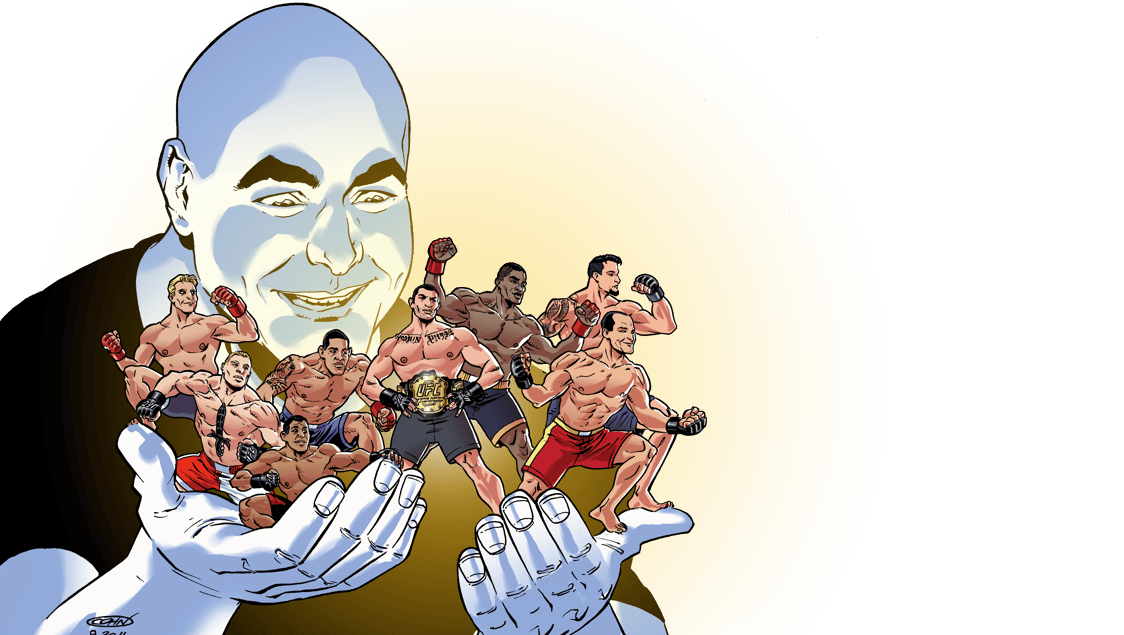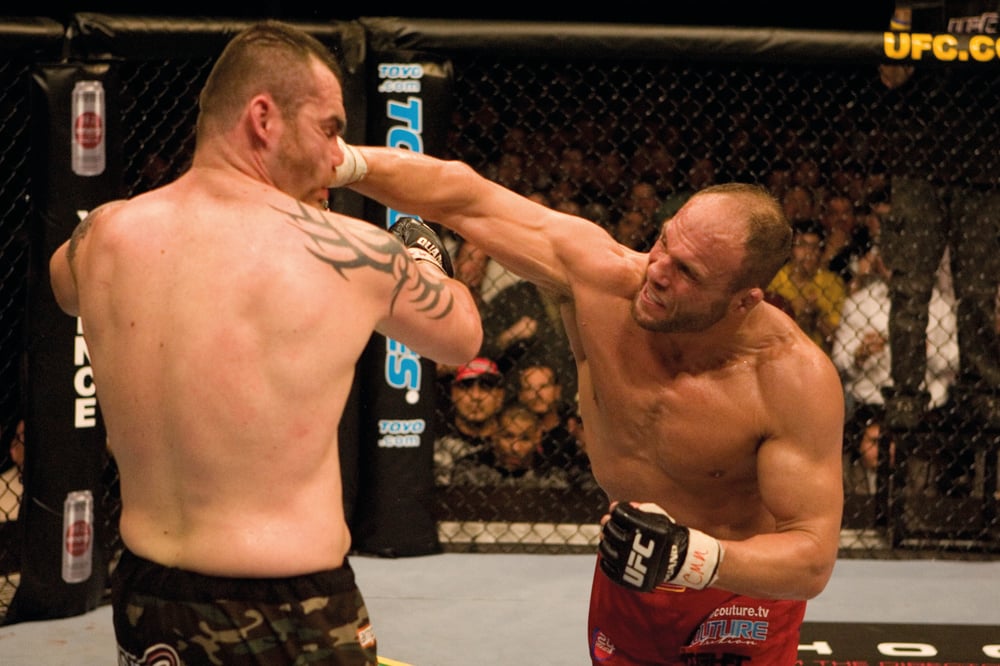
Issue 082
December 2011
The heavyweight championship of the world used to be the pinnacle of sporting competition but for almost a decade the ring has diluted the crown – it’s now time for MMA to step in and fill the biggest vacancy in world sports.
Believe it or not, it’s now been eight years since Lennox Lewis cut open and defeated Vitali Klitschko in a world heavyweight title fight for the ages. Since then very few heavyweight title match-ups have lived up to the six rounds Lewis and Klitschko served up in the Staples Center. Widely regarded as the last great heavyweight encounter, Lewis’ victory over Klitschko also unknowingly marked the end of the blue riband division as we once knew it. Lewis retired shortly afterwards, while Klitschko became, well, Klitschko, one of the most clinical champions of all time, yet also one of the most desperately bland.
So what has happened to the heavyweight division since Lennox decided to up and leave? Well, despite the fact very little has lived up to that war in LA almost a decade ago, there have been a number of sterling clashes between big men that have regurgitated lost memories of the once golden era of combat sports. How about Russian Fedor Emelianenko’s classic wars with Antonio ‘Minotauro’ Nogueira and Mirko ‘Cro Cop’? They weren’t exactly bad. Oh, and don’t forget Randy Couture’s against-all-odds domination of Tim Sylvia for the UFC heavyweight belt.
And then there’s Brock Lesnar, the former WWE superstar who helped transcend the heavyweight division and bring it back to mainstream attention. His fights with Frank Mir, Shane Carwin and Cain Velasquez harkened back to a time when the heavyweight championship of the world was the most coveted title on the planet. Those fights and fighters helped the heavyweight division rise to some sort of prominence again, perhaps for the first time since Lennox Lewis and Mike Tyson kissed goodbye to their primes and allowed an influx of Eastern Europeans to anonymously run things in the ring for the foreseeable future.
Yes, it’s now become abundantly clear that mixed martial arts has carried the heavyweight division into the 21st century and allowed boxing, a sport steeped in history and tradition, to rest on its laurels and take the decade off. Lennox left, the Klitschkos combined and the rest of the division got older, fatter and less ambitious as the years went by. Potential young American heavyweights decided to bounce an orange ball or accumulate yards rather than punch bags and, subsequently, the land of hope and glory has boasted neither hope nor glory inside the ring since the best days of Tyson and Evander Holyfield.
Mixed martial arts, meanwhile, though hardly stacked in the contender department, either, throughout the last decade at least boasts a model that allows the best to fight the best.
Belts are few and far between and the Ultimate Fighting Championship covers at least 90% of the elite division with its substantial umbrella. That level of control is a positive thing for the division and eradicates the kind of politics that have forever blighted boxing. MMA lacks one Klitschko, let alone a pair of them, but that can either be seen as a positive or negative.
On the one hand there has yet to be a dominant, universally respected heavyweight champion roaming the mixed martial arts landscape the way the Klitschkos have done in boxing, but on the other hand that sense of competition has only increased the sport’s unpredictability. After all, most fans would rather see 10 hungry heavyweights staking a claim for the belt and occasionally playing pass the parcel with it than two stoic Ukrainians hold on to their toys and refuse to let anybody else play with them for 10 years. Maybe it’s just me, but the MMA ideology seems a lot more fun.
Of course, that doesn’t mean to say mixed martial arts fans haven’t been blessed with a number of genuinely great and memorable heavyweight champions over the years. Despite a recent fall from grace, Emelianenko was once the sport’s flagship heavyweight and a man who stretched an unbeaten run to its limit in Japan, before stalling in mediocrity for too long and forgetting that most of his peers resided in the UFC, an organization the Russian failed to ever compete in.
Nevertheless, Fedor’s unbeaten streak, as well as his mystique and engaging style, means he will forever be remembered as a great heavyweight, regardless of how many Brazilians and light heavyweights he goes on to lose against in the coming years. In fighting style alone, he was the antithesis to the Klitschkos and a man that attracted spectators to his sport – underground and largely taboo at the time – rather than drove them away.
Fedor’s legendary reputation was, of course, amplified by long-running rivalries with Antonio ‘Minotauro’ Nogueira and Mirko Cro Cop, two of the other pre-eminent non-UFC heavyweights of his era. Head-kicker Cro Cop and arm-breaker Nogueira are considered legends in their own right and remain fan favorites on account of a back catalog of thrilling ring wars in Japan. While nobody would be foolish enough to label any of the aforementioned Pride champions household names, this trio overcame the language barrier with highlight reels of knockouts and submissions. They carved their names into heavyweight history the old-fashioned way, through fights and excitement.
Across the Pacific in the UFC, however, the job of torchbearer was left to Randy ‘The Natural’ Couture, the former three-time UFC heavyweight and two-time light heavyweight champion and, perhaps, the greatest heavyweight character since Tyson. Yes, we can talk for days about Couture’s epic battles with the likes of Tim Sylvia, Gabriel Gonzaga, Pedro Rizzo and even Nogueira at the tale end of his career, but what really cemented him as a star was the fighter’s magnetic personality, back story and willingness to bleed for his profession.
Couture was an ambassador for mixed martial arts, both inside and outside the Octagon, and cared for the sport and the heavyweight division in a way that most of his boxing peers could never possibly dream of. Moreover, the appeal of Couture was rooted in the idea that you were watching your beloved uncle fight each and every time he touched gloves with a younger and bigger foe. You dearly cared for the man.
Now it’s all over, of course, and Couture has since been ushered to the comfy leather chair many have been directing him towards for the best part of 10 years. Encouragingly, he seems to have left the UFC’s heavyweight division in safe hands. Nogueira and Cro Cop are still hanging around with mixed fortunes, but the rest of the division are gunning for the title with fresh ideas and relatively clear heads. Brock Lesnar may no longer be champion – that distinction now goes to Cain Velasquez – but he remains the most marketable and watched heavyweight in all of combat sports, at least as far as the American market is concerned.
While the fighting Klitschko brothers draw staggering viewing figures in their adopted Germany, they have yet to emerge in the hearts or even minds of America, yet Lesnar, the former wrestler turned legit MMA champion, carries the look, physique and personality to make everybody sit up and notice. He knows how to play the game and is aware that in 2012 no heavyweight is going to become famous purely through fighting capabilities.
There is now a great need for some semblance of style and swagger and Lesnar, whether loved or hated, possesses both in abundance. He is controversial and edgy, much in the same way Tyson was during the ‘90s and, though his fighting skills don’t match up to the ferocity of his tongue, it doesn’t matter. People will tune in to watch Lesnar until the day he decides he’s had enough.

As Lesnar waits for his cue to return to the Octagon (he is scheduled to face UFC new boy Alistair Overeem on the eve of New Year’s Eve), the rest of the division looks to flourish in the new-found spotlight he has provided for them all. Champion Velasquez possesses the fresh face, fighting talent and story to break down boundaries, but, like Lesnar, has also recently been plagued by injury. He returns to the Octagon this November 12th against Junior Dos Santos, the Brazilian with heavy hands, confusing ears and a winning run as impressive as anybody in mixed martial arts right now.
At 29 and 26 years of age respectively, Velasquez and Dos Santos are the two hottest commodities in heavyweight fighting right now and, with that in mind, their championship clash – which will be the first UFC event to be screened live on Fox in the US – would appear destined to return this great division to where it once sat, at the very top of the sporting spectrum.
Refreshingly, fights as big as this have rapidly become the norm in the UFC’s heavyweight division, and that reflects well on both the health of the weight class and the intentions of the organization. While boxing promoters may have been tempted to guide both Velasquez and Dos Santos down separate paths and exasperate fans for as long as their nerve would allow, Dana White and the UFC are keen to stage marquee events in a division that once freely churned them out on a regular basis.
Naturally, once Velasquez and Dos Santos have sorted out their issues, skeptics will then start to wonder what other heavyweights can pick up the baton and launch a serious offensive on the sport’s grandest belt. Former title holders Frank Mir and Shane Carwin still figure highly in the pecking order, but neither would be favored to defeat the two men slated to contest the crown in November. The eminently watchable Lesnar, meanwhile, has already faced the wrath of Velasquez and came off second best, and may not fair any better in a brawl with Dos Santos, either.
So, when stepping away from that fearsome top two, the rest of the UFC’s big men fall somewhat flat, at least for the time being. There is still hope that the likes of Travis Browne, Matt Mitrione and perhaps even Stefan Struve mature to the point where they’d be able to offer a viable challenge at the pinnacle of the division, but very few up-and-comers arrive equipped with any form of a guarantee. In fact, as far as surefire prospects go, the heavyweight division is perhaps the emptiest weight class in the sport right now.
That could soon change, of course, but, for the time being the UFC title’s next threat may instead arrive in the form of a winner or also-ran from this year’s Strikeforce heavyweight Grand Prix. While Overeem has already made the switch to face Lesnar at the end of the year; Josh Barnett, Daniel Cormier and Antonio ‘Bigfoot’ Silva are serviceable at worst and dangerous at best and could eventually help expand the UFC’s skinny heavyweight roster.
So it’s clear that the process of turning this current heavyweight crop into the kind of pick-’n’-mix rack boxing fans had to choose from in the ‘60s and ‘70s isn’t going to be a simple overnight process. There are still nowhere near enough credible contenders to the throne, and many of the current contenders are on the wrong side of 30. That needs to and will change in the coming years, as mixed martial arts continues to grow and becomes an option for kids inclined to go pick up a basketball, baseball or football.
For the time being, however, the sport will go with what it already has at its disposal and take heart from the fact it is still infinitely more enticing than what boxing currently has to offer. Furthermore, the key component that ensures mixed martial arts’ heavyweight division will always be exciting, irrespective of the talent pool, is the fact the men at the top are willing to match contender with contender and determine a true and single champion as quickly as possible. That attitude alone will always stand MMA’s heavyweight landscape in great stead.
Making history
The impact of the UFC’s landmark deal with Fox television, and how that undoubtedly helps increase the exposure of mixed martial arts in general as well as the profile of the heavyweight kingpin, cannot be underrated. Watching the heavyweight champion on TV used to be an unmissable event in households the world over.
The visibility of the champion at the top of the division is nearly as important as victories chalked up and Fox will be key players in helping Velasquez, or his successor, maximize their profile and establish themselves as the premier fighting talent in all of sports.
The heavyweight champion of the world is a vacancy that has been open and lacking worthwhile applicants for far too long now. The grand old heavyweight division, one-time home to some of the biggest, baddest, meanest and maddest fighters of all-time has of late been far too quiet and far too light for its own good. It’s time to get heavy again.
Great heavyweight moments
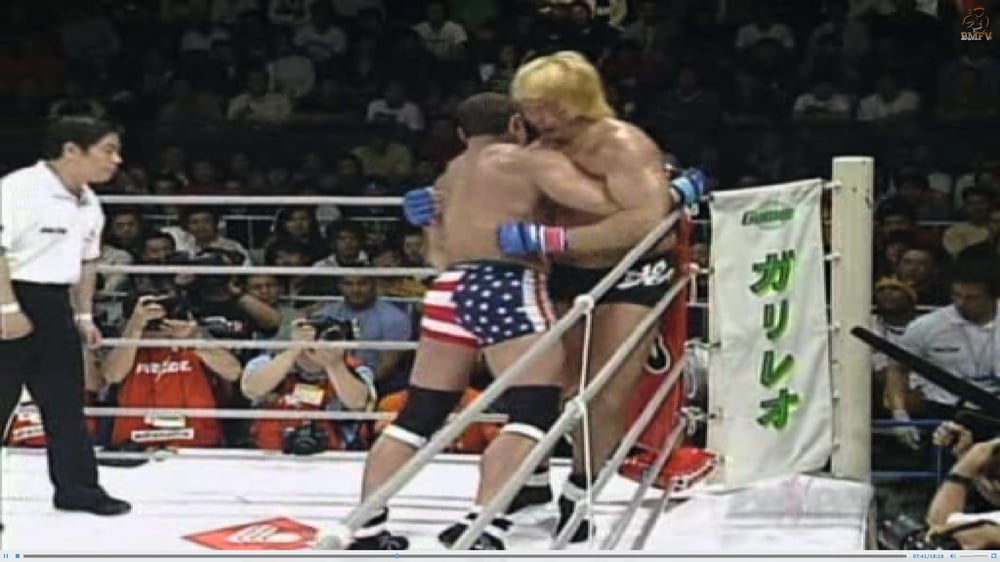
1. Frye and Takayama refuse to stop (June 2002)
Try and imagine leaning in for a kiss or embrace with a loved one, hand cupped behind their neck, heads moving closer, only to then be greeted with a closed fist coming back the other way. Scared? Okay, now picture that fist raining down on your face for the best part of a minute, while you instinctively react and try doing the same, all the while throwing the occasional jumping knee for good measure. Faces distort, blood runs and this bizarre sequence continues until one of you is no longer able to open your eyes or breathe. Yeah, that’s what happened the night Don Frye and Yoshihiro Takayama decided to go crazy in Japan. Oh, and the stare-down alone was better than most fights.

2. Lesnar grows, subs Carwin (July 2010)
Crucial to the history of the division simply because this was the fight that highlighted the evolution of a derided professional wrestler into a fully-fledged UFC champion. Brock Lesnar weathered a hellacious early storm against Shane Carwin at UFC 116 before sucking it up, dragging the fight to the floor and then somehow slapping on an impressive choke, from which his challenger would quickly tap. It was a move and style of fighting many felt was beyond Lesnar’s novice grasp of the sport, yet he turned a corner in desperate circumstances and went from caterpillar to butterfly in due course.
3. Old man Couture shocks Sylvia (March 2007)
The right hand Randy Couture landed on the jaw of Tim Sylvia in the first round of their UFC title fight has been replayed many times since it happened, and for very good reason. It marked the return of Couture, a man who had previously retired following a 2006 defeat at 205lb to Chuck Liddell. Off the shelf and back as a heavyweight, Couture conceded upwards of six inches in height and 40lb in weight to UFC heavyweight champion Sylvia and was considered by some a mere stepping stone on the new titleholder’s path. Instead, that opening right hand brought an entire crowd to its feet and signaled the start of one of the UFC’s greatest ever upset victories. Some 25 minutes later and Couture was once again crowned heavyweight king, having emphatically outworked Sylvia through five rounds.
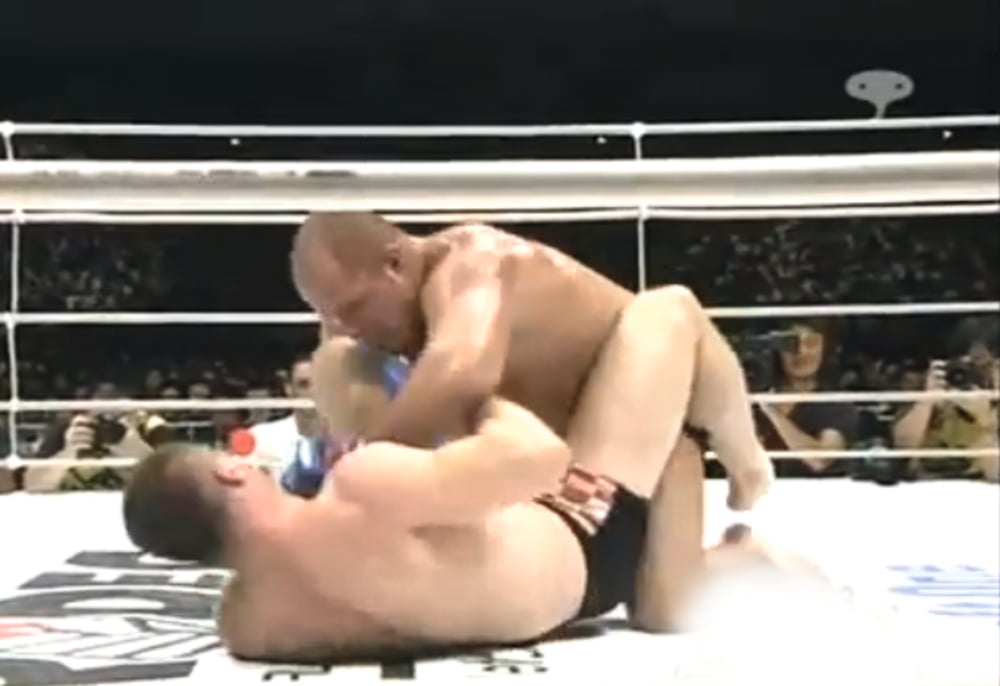
4. Fedor and ‘Cro Cop’ serve up a superfight (August 2005)
Originally scheduled to take place in 2003, this match-up between Fedor Emelianenko and Mirko Cro Cop, like most heavyweight blockbusters, ended up getting kiboshed and instead happened two years down the line. In hindsight, it was more than worth the wait. The seemingly invincible Fedor had lost only once (via cut) in his entire career, while Cro Cop had embarked on an incredible seven-fight win streak, which included six first-round stoppages. Anticipation and fighting styles led to this meeting being heralded as one of MMA’s true superfights. It didn’t exactly disappoint, either. Fedor was stunned and suffered a broken nose in the first round, before taking Cro Cop south and emptying his gas tank with a series of body and head shots. By the time the 20 minutes was up, Fedor had proven his dominance on both the ground and in the stand-up and walked away with a unanimous decision and spotless reputation.
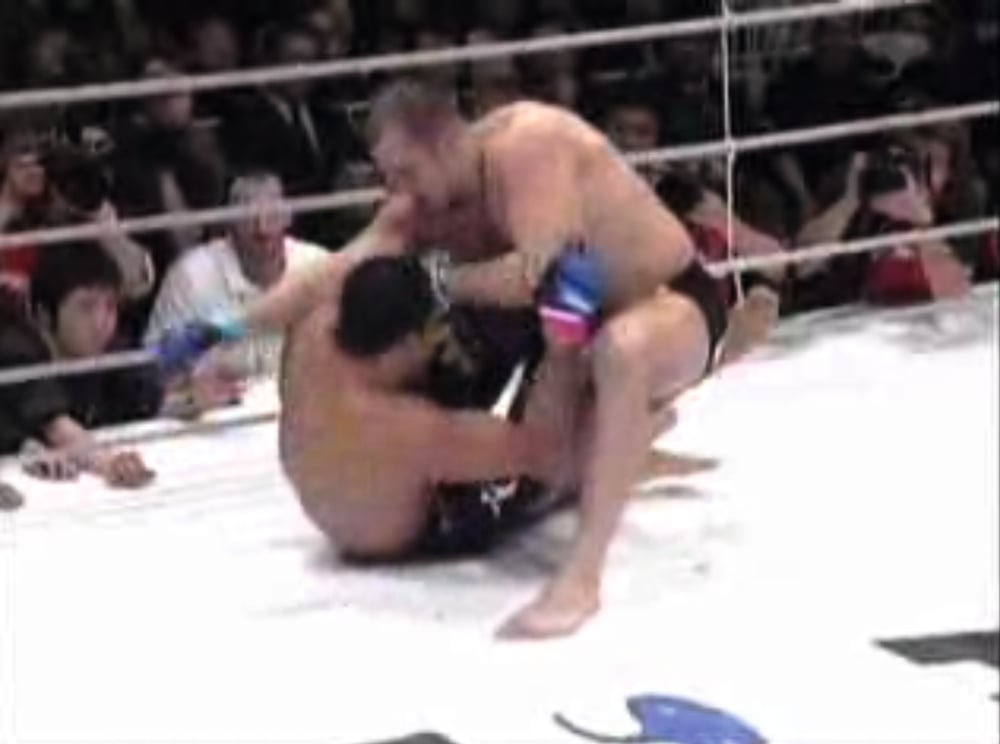
5. Fedor and ‘Big Nog’ introduce themselves (March 2003, August and December 2004)
Although a little short of the famed Ali-Frazier trilogy, the three fights shared by Fedor Emelianenko and Antonio ‘Minotauro’ Nogueira meant just as much to an entire generation of fans eager to follow Pride’s beloved heavyweight division in the noughties. The second fight between the pair, ended prematurely due to a cut, might be worth swerving, but the first and third wars stand alongside anything that has ever been tagged mixed martial arts. The pair first met in 2003, Nogueira as a feared champion and Fedor as an unproven contender keen to make his way in the sport. Fifteen minutes passed and the world woke up to the talents of the relentless Russian, as he scored a decision victory and snatched away Nogueira’s belt. The two men then met twice more in 2004, the second of which was another three-round classic, shaded by Fedor down the stretch. All in all, through nearly 40 minutes spent in one another’s company, these thrilling heavyweights announced themselves as two of the very best to ever do it.
...
